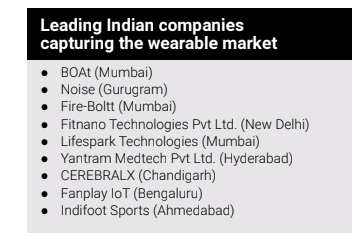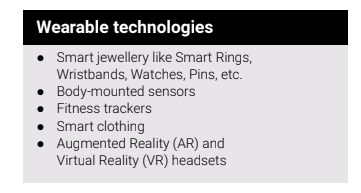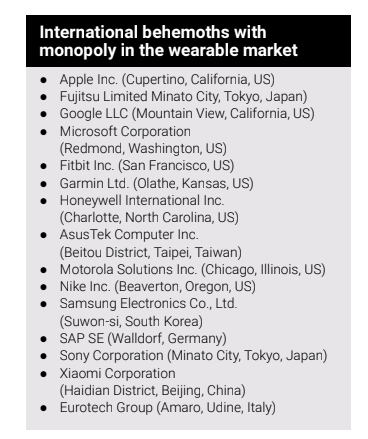Rise of Healthcare Wearables
August 01, 2023 | Tuesday | Features | By Pramita Bose
The wearable healthcare market in India is rapidly growing due to the increasing awareness of health and fitness among the Indian population, the prevalence of chronic diseases and the government's support for the adoption of wearables. Of course, there are a few challenges that need to be addressed, such as the lack of regulatory guidelines for wearables, the high cost of some devices and the lack of awareness about the benefits of wearables among the general public. Let's explore further the fate of this sector.
One of the pivotal post pandemic questions is, whether the healthcare and medtech industries are being flooded with artificial intelligence (AI)-enabled products and services for better functionality and supervision.' From surgical robots to fitness trackers, hospices and clinics are loading hi-tech equipment to upgrade treatment procedures and patient outcomes. And the change is pretty noticeable.
There are a slew of state-of-the-art wearable products that promise to improve our health by constantly measuring our medical parameters. Artificial intelligence (AI) hearing aids, Google Glass, Microsoft's HoloLens and a holographic computer in the form of a virtual reality (VR) headset are much in demand in healthcare.
Wearable technology in the healthcare industry refers to electronic devices like smartwatches and Fitbits that collect personal health and fitness data.
“These devices have become increasingly popular, with their usage more than tripling in the past four years, and the market is growing by 25 per cent each year,” says Dr Manoj Bansal, consultant at Interventional Cardiology, Kokilaben Dhirubhai Ambani Hospital, Indore.
Initially, wearable fitness trackers in the form of wristbands were used to monitor physical activity and heart rate. But now, ultrasmart wearable devices come with advanced features like GPS tracking for emergencies and fall detection. They even allow users to send urgent notifications. The devices help people achieve their fitness goals by tracking steps, distance, intensity, calories, and also monitor body patterns and sleep quality. For instance, Apple's Apple Watch boasts of additional health-tracking abilities, such as notifying users about irregular heart rhythms or abnormally high or low heart rates.
Specific wearable devices cater to women's health needs too. For example, the Ava bracelet helps women track their menstrual cycles, fertility, pregnancy and overall health. In healthcare settings, wearable devices like blood pressure monitors and continuous glucose-monitoring devices enable healthcare professionals to closely monitor patients' health conditions.
“Healthcare systems across the globe are facing unprecedented challenges. In India, the situation is no different. With a population over 1.4 billion, the country's healthcare infrastructure is under immense pressure. In such a scenario, wearables play a crucial role in improving patient outcomes and reducing the burden on healthcare providers,” comments Dr Sachin Suresh Jadhav, group head of Haematology and Stem Cell Transplantation, HCG Network (of cancer centres), Bengaluru.
The HCG Network leverages sophisticated AI technology in the form of Dozee’s remote patient-monitoring and AI-based early warning system. Health experts certify Dozee as a great modernised technology solution. “Credited with its non-invasive approach and real-time data insights, this innovative medical equipment can revolutionise the way healthcare is delivered in the country as we navigate the difficulties of acute diseases and beyond,” assures Dr Jadhav.
In recent years, the healthcare industry frequently resorted to wearable products and its technological infrastructure to cater to the needs of oncology patients more effectively. To facilitate this process, the product line consisting of smartwatches, remote sensors, VR and AI-based solutions proved immensely useful. The items monitor the vital signs and activity levels to provide physicians with real-time data on the concerned patient's physical condition, thereby enhancing his/her quality of life. The treatment process of oncology patients underwent a major transformation, thanks to the e-age blessing of wearable technology. All in all, innovation led to correct data collection, prompt service delivery and clear transmission of diagnostic information among the stakeholders involved in a patient's care journey.
Additionally, wearable AI can assess a user's speech patterns, track heartbeats, weigh the prevalent mood and communicate warning signals if any. In a nutshell, comprehensive health data is conveyed to respective users via voice assistants and real-time insights.
India’s position
The domestic wearable healthcare market in India is rapidly strengthening. As per a Research and Markets report, it is predicted to reach a value of $1.26 billion by 2025, up from $310.4 million in 2020.
“This surge is owing to increased awareness of health and fitness among the country’s population, the prevalence of chronic diseases and higher healthcare spending,” states Chandra Ganjoo, group Chief Executive Officer (CEO), Trivitron Healthcare, a leading medical devices company and equipment supplier to the healthcare industry.
The most popular healthcare wearables in the emerging market of India are fitness trackers, smartwatches and health-monitoring machines that can track heart rate, blood pressure and sleep patterns. The COVID-19 pandemic has over the past three years undoubtedly accelerated the adoption of healthcare wearables closer home, with consumers seeking remote-monitoring solutions.
To encourage more uptake in this largely developing market, the Indian government launched a host of initiatives, such as the National Health Stack to create a unified digital health infrastructure to integrate a greater number of wearables into the healthcare system. “As consumers prioritise their health and healthcare providers rely more on technology, the nationwide healthcare wearable market is only expected to expand steadily,” Chandra lays an emphasis.
According to Aashish Kumbhat, co-founder of URBAN, a premium smart wearable brand, there’s a remarkable level of interest building around smart wearable products like smartwatches and fitness bands in India. “These appliances became exceedingly popular because they provide users with real-time health data and insights, helping them track and monitor their fitness and wellness goals,” he reasons. Further, the techie insists that “overall, the healthcare wearable market in India is believed to possess a tremendous potential for growth and the wearable manufacturers are committed to provide a bevy of innovative and user-friendly smart wearables that can help people live healthier and more active lives.”
As a counterpoint, he submits that India is an evolving but still a very price-sensitive market as compared to the global one. The growth opportunity is enormous as the Indian customers are relatively younger and invest a chunk in having a healthy living. However, the hyper price-sensitivity often poses a challenge to providing quality technology.
Pros & Cons on Home Turf
“The inland healthcare wearable arena presents ample growth opportunities compared to the global market. India's swelling population is getting health-conscious by the day, spurring demand for healthcare wearables. Plus, the central government’s support and push for embracing wearables are lending an added fillip to the market’s flourishing prospects,” volunteers the voice from the Trivitron top brass. “There are, however, more hurdles to tide over. One challenge is the general public's lack of education in wearables,” Chandra rues. “Another demerit is the dearth of regulatory guidelines for wearables, which can hinder invention, evolution and acceptance. Moreover, affordability is a key concern in India, where much of the populace is still in the low-income bracket,” she elaborates ahead.
Compared to the global market, India's healthcare wearable space is still in a nascent stage but shows enough promises to prosper. The global market is more mature and competitive, with established players and a broader product and service portfolio. “However, the Indian market is bubbling with possibilities owing to the advantage of a vastly untapped population and a soaring demand for healthcare solutions, thus unlocking a significant scope for growth,” shares Chandra Ganjoo.

With the rise in people’s inclination towards monitoring their health and wellness, the demand for wearable gizmos is estimated to further augment. “So, it would be befitting to say that the desi scenario is brimming with boons as well as banes,” seconds Kumbhat. “As far as shortcomings are concerned, one of the main obstacles we face here is ensuring that our devices are accurate and reliable. As these apparatuses are often used to track vital signs or parameters and other health-related information, it's important that they provide exact data,” he opines.
The advantages of wearable technology in healthcare are numerous. These devices encourage proactive healthcare, engage patients in managing their health, curtail healthcare costs and lessen the workload on healthcare staff. However, there are some challenges associated with these devices. Technical issues, inaccuracy of data, security and privacy concerns and errors due to improper wearing can also arise.
“Despite these drawbacks, the wearable technology industry is burgeoning fast. Every day, smarter apps are being developed that are more user-friendly and faultless. The amalgamation of artificial intelligence with healthcare is also reinforced substantially, further enriching the competence of wearable devices,” Dr Bansal buoys optimism.
Product menu driving demand
An array of various products currently bolsters demand in the fitness and medtech industry. Fitness trackers, smartwatches and health-monitoring devices offer features, such as heart rate monitoring, blood pressure tracking and sleep tracking, allowing users to keep tabs on their health and fitness levels. This apart, wearable technology that can track physical activity and provide real-time feedback on performance is gaining momentum among the fitness enthusiasts at the moment. Within the medtech industry, certain widgets are widely wooing the target consumers by providing remote patient-monitoring facilities. These became hugely popular, especially following the COVID-19 pandemic. For example, pulse oximeters were flying off the shop shelves at the peak of the pandemic for watching basic health conditions within the confines and comforts of one’s home during the lockdown phases. Wearable technology that can track body temperature and symptoms of the coronavirus also witnessed a spike in demand as people keep exploring ways to check their health while maintaining social distance.

Smartwatches and fitness bands are the most sought-after tools used for measuring fitness and health metrics, such as steps taken, heart rate, sleep quality and much more. Calibrated devices aid in inspecting health by keeping track of cholesterol levels, calories burnt, oxygen levels, etc., through sensors. Also, several reputed companies, namely Fitbit, Samsung, Noise and Fossil Group, Inc., are introducing the upgraded versions of intelligent watches and other smart accessories with more advanced health-tracking options.
Improved patient outcomes
One wonders if the explosion in technology is helping healthcare personnel and medical experts serve their patients in a better fashion and with more precision. “It’s a no-brainer that the technology boom uplifted healthcare by several notches in terms of providing healthcare workers and medical exponents with a new set of tools to serve patients with more accuracy and efficiency,” confirms Chandra.
Good news is that the Electronic Health Records (EHRs) replaced traditional paper-based documents only to simplify the process of accessing and sharing patient data in real time to benefit healthcare providers. Besides, telemedicine allows the healthcare staff to remotely diagnose and treat patients on video conferencing, mobile apps and other digital platforms. Progression in medical devices, such as MRI and CT scans, and robotic surgery, leads to near-perfect diagnoses and minimally-invasive procedures.
Health apps enable patients to scrutinise their health status, get actively involved in their recovery stages and deliver valuable stats to healthcare providers. While on one hand, difficulties exist, on the other, technology in healthcare fetches numerous benefits to effectively attend patients’ unmet medical needs with continued efforts.
Kumbhat agrees that “early diagnosis is thankfully easier now and is giving medical experts more time to contemplate and treat serious ailments. Since it’s become a hassle-free affair for commoners to examine their physical constitution, any minor irregularity is instantly detected and redressed on time.”
COVID cushion
It is true that wearable technology including fitness trackers was already grabbing attention before the pandemic had struck globally but has general health awareness grown by leaps and bounds during COVID-19 that inflated market growth? “The COVID situation definitely boosted market growth on the back of heightened focus on health and wellness during a global emergency. Therefore, sales of wearable fitness devices like smartwatches, fitness bands and other health-probing gadgets skyrocketed,” thinks Chandra.
“The global wearable technology market size is predicted to magnify from $27.91 billion in 2020 to $74.03 billion by 2025, with healthcare and fitness being the key catalysts for this upside. Wearable technology thrived as a universal lever in the healthcare industry for virtually monitoring patients and dispensing personalised care by the medical experts, tracing vital signs like heartbeat, blood pressure, blood oxygen levels, physical activity levels, sleep patterns and medication adherence,” she further corroborates.

“Another noteworthy aspect is that the corona era gave an impetus to the creation of wearable technology that could specifically identify the early signs of infection,” reports Kumbhat. The prudence of wearables comes with the biggest gain of rendering doctors with real-time data to make informed decisions.
The confidentiality factor
Maintenance of patient privacy by safeguarding their data evokes a significant risk in wearable technology, especially given the vast amount of sensitive personal information that the electronic devices collect and transmit. The bulk of records can include health and fitness reports, location data, biometric data, thus making it a prime target for cybercriminals or hackers to easily carry out identity thefts, fraudulent practices or other malicious activities. The potential perils of data breaches associated with wearable technology have time and again surfaced in several high-profile cases, underlining the importance of data protection.
To address the concern over data compromise, wearable technology companies are implementing rigid secrecy policies and encryption measures to defend user data. Encryption ensures that data is transmitted securely between the device and the cloud servers while the users are typically required to provide explicit consent before their data gets collected and used. Additionally, many companies adopted biometric authentication methods to enhance security.
User awareness is also paramount as they must carefully review the privacy policies and terms of service agreements before using wearable devices, limit the extent of personal information shared and use strong passwords as well as two-factor authentication to protect their accounts. By taking these precautions, users may continue to enjoy the fruits of wearable technology and minimise the risks looming on their personal data.
“We stick to industry standards to ensure compliance with data privacy regulations. Our devices are extremely user-friendly and are designed keeping the privacy issue in mind. The gadgets offer users full control over their personal data. We always make sure to place a foolproof data safety policy in place even when we collaborate with different partners. So, products will be safe to use without the fear of data loss,” assures Kumbhat.
Man Versus Machine debate
Clever devices with smooth handling are unquestionably ruling the roost. But can the efficacy of wearables replace the skills of manual labour of an efficient practitioner who would physically run, regulate and note down the readings from traditional devices? “Wearable technology may never be a substitute for manpower or pose a threat to the capable pairs of human hands but can certainly streamline the healthcare process,” concedes Chandra Ganjoo. With advanced sensors and real-time data tracking, wearable devices can provide apt and updated material, enabling appropriate monitoring and treatment. While it may not completely eliminate the need for physical alertness but can certainly enhance the attendant's abilities and improve the patient outcomes.
Kumbhat attempts to set the record straight by saying “Wearable products like smartwatches and fitness bands are designed to raise the performance standard and complement the work of healthcare professionals, and not to outdo them.” Wearable technology’s accumulated data could be an essential source of analysis for the healthcare practitioners to closely understand a patient's health and determine their line and method of care. This technology can convincingly aid healthcare professionals to apply timely interventions and mitigate the unwarranted risks.
Financial feasibility
Industry observers admit in unison that the Fourth Industrial Revolution or Industry 4.0 envisions a rapid change in technology, businesses and society in the 21st century, courtesy advanced networking facilities and smart automation. Evidently, the wearables market is seeing a visible boom, given that our lifestyle is being completely driven by cutting-edge technology. With the rise in e-commerce during the pandemic, the e-gadget space has presumably expanded of late. Smart watches, VR headsets, wearable electrocardiograms, e-textiles, fitness trackers, smart glasses are flooding the markets both online and offline.
Wearables are electronic devices that are designed to be used while worn. The product range is widely categorised into wristwear, headwear, eyewear, footwear, fashion accessories, bodywear, gym wear and gear, plus medical instruments and elements of e-dresses.
On the flipside, wearable technology is economically viable in India only on paper. Not all hospitals, fitness centres and health clinics can actually afford these devices. “While the market for wearables in India is spreading its wings, cost intensiveness remains a significant barrier for many healthcare providers,” Chandra Ganjoo quashes all speculations. “However, as the technology becomes more ubiquitous, cost sensitivity will decrease gradually to make wearable devices more accessible and widely adopted in the healthcare industry,” she adds.
“Technology is the key driver of economic advancement. The GDP of India bumped up on innovation and liberalisation. With the wave of digitalisation having invaded almost every other sector, the wearable space did not remain immune to its impact either,” elucidates economy expert Sangeeta Shroff, the professor-in-charge of Agro-Economic Research Centre at the reputed Gokhale Institute of Politics and Economics.
Kumbhat explains, “To ensure high-quality technology and accurate results, I recommend choosing a wearable device from a reputable brand, which prioritises both sensors and the technology incorporated, recognising that nothing is more precious than human life.”
For a critically ill patient with comorbidities, be it in general wards or in intensive care units, the cost of treatment can be overwhelming. In the case of a cancer patient, right from chemotherapy to radiation therapy, the expenses could speedily hit through the ceiling. With uber smart wearables, patients can now avail the rewards of remote health monitoring, thus curbing the need for frequent hospital visits and reining in those exorbitant medical bills.
Pramita Bose













